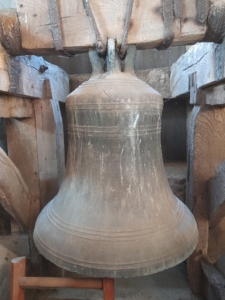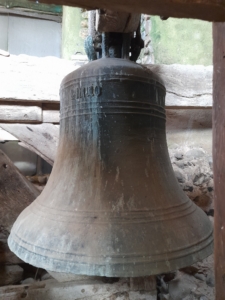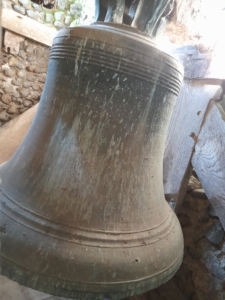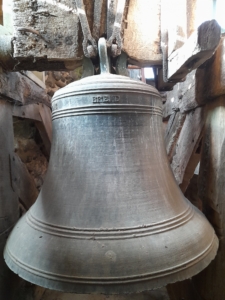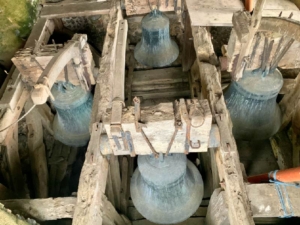The Bells of St Nicholas
The tower of St Nicholas’ church holds four bells which are currently stood down on timbers for safety reasons, while awaiting restoration work. The details of the bells are as follows:
Treble – 4½ cwt – 28″ – D♭ – 1615 – William & Alice Brend
Second – 5¼ cwt – 29¾” – C – 1615 – William & Alice Brend
Third – 6¾ cwt – 33″ – B♭ – c1499 – Unidentified (blank)
Tenor – 8 cwt – 36¾” – A♭ – 1641 – John II Brend
The History of the Bells
The 1552 Inventory of church goods records three bells in the tower. The weights of these bells were recorded as 5 cwt, 7 cwt and 8 cwt. It is believed that the third bell in the tower is the 7 cwt bell referred to in the inventory.
In 1615, two bells were cast by William & Alice Brend, to replace the previous two bells that were removed in 1552. These bells would later be augmented into four with the addition of a new bell cast by John II Brend in 1641.
The bells were originally hung in an oak frame which consists of sills, double diagonal braces and long frame heads, all mortised together and pegged. The frame was originally made for three bells, with the central pit having been extended to contain two bells swinging mouth-to-mouth. It is thought that the frame dates from no later than the early part of the 16th century.
There are signs that the bells were previously hung for full-circle ringing, but are no longer capable of being rung in full circles. They were at a later date rehung for swing chiming, with the headstocks being fitted with timber chiming levers. The bells were originally rung from the ground floor of the tower as the ceiling of the ringing chamber still has the old rope circle.
The Current Condition of the Bells
Throughout the years, the bells and frame had both fallen into a derelict condition with the bells being in a dangerous condition and no longer being able to be used. The timbers of the frame have become heavily weathered, but remain quite capable of supporting the bells provided they are not swung.
As for the bell fittings, the headstocks are heavily denatured, but are structurally sound enough. However, the same could not be said for the strapwork by which the bells were originally supported. The straps which were secured by nuts had became heavily corroded and were designed to be secured by keys or wedges. These were a major cause for concern, as most of the wedges had rusted away. Overall, the safety of the bells were perilous to say the least.
For a while, only one of the four bells (the tenor) was capable of being chimed via a rope tied to the clapper. Apparently, the tenor bell has not been heard chiming for over 50 years.
Plans for the Restoration Work
As part of the first phase of the restoration work, the bells have been lowered from the frame and are now stood down on timbers. This has been done to make the bells safe while other options are considered on how they can be restored.
Funding for this first phase was kindly provide by the Geoffrey Watling Charity.
The ideal option for the bells to be restored is for them to be hung dead in the existing frame, were they will all be chimed with electro magnetic hammers.
Recordings
Below are some recordings that were taken of the bells prior to them being lowered. The first 4 videos are of the bells being chimed individually, while the last video is of all the bells being chimed together. This will give you an idea of what each bell sounds like.
The Treble Bell
The Second Bell
The Third Bell
The Tenor Bell
The four bells pealing
Photographs
The treble bell cast by William & Alice Brend of Norwich in 1615
The second bell cast by William & Alice Brend of Norwich in 1615
The third bell cast by an unidentified founder around 1499
The tenor bell cast by John II Brend of Norwich in 1641
The view of the bells and frame. This photograph was taken prior to the bells being lowered.

